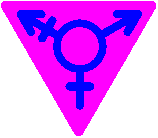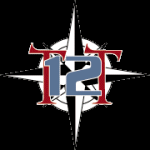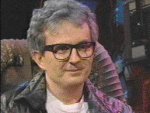
B.C. on Gender: Queer Space
Toronto Trek and Queer Programming

For several years in a row, I attended a panel at Toronto Trek called Queer Space -- this panel was run by "Commander Glam" and members of the Toronto queer community. The whole purpose behind this panel was to discuss queer characters on Star Trek and other science fiction shows (or, more to the point, the notable absence of those characters). I enjoyed the panel a lot; there were interesting opinions, and interesting people. Of all the panels I frequented, this was the panel were I routinely made friends.
Unfortunately, the panel wasn't scheduled for Toronto Trek 10. And it was absent from TT11's programme, as well. (I'm told that this isn't due to any censorship by the Toronto Trek Con Com, but rather because Commander Glam fell out of contact with the organizers, and the programming people had difficulty finding panelists who were "out" enough to be on the panel).
The good news is that queer programming returned at Toronto Trek 12 -- Commander Glam hadn't returned, but a "Next Generation" of queer folk turned up to run the panel. And that made me very happy... except... I do regret that the new crowd didn't know any of the topics or discussions from previous Queer Space panels. So some time was spent going over the same old topics.
I'm gonna take a few minutes to write out my thoughts about queer Trek.
The way I see it, a discussion about queer topics in science fiction shows can have a few dimensions:
- the notion of stereotypes -- how do we recognize queer characters when they're used?
- a discussion about the appropriate stories for GLBT characters
- a review of some of the highlights of queer ST:TNG episodes
Hi-Fi Stereotypes
I was driving to Waterloo with a friend of mine, one day, and he was telling me about the gay and lesbian science fiction club he belonged to (the now-defunct Toronto chapter of the Gaylaxians. One of their favourite activities, he told me, was to debate whether or not certain characters in TV shows like Star Trek were coded as gay.

Fajo
Take, for example, the character, Fajo, from the ST:TNG episode "One of a Kind". Remember: Fajo added Data to his collection of one of a kind things.
Was this character gay? Did the actor play the role a bit effeminately? Was there an overtone of homoerotica when Fajo destroyed Data's Star Fleet uniform?
Personally, I didn't read the character as gay at all. And yet, some people did.
So, suppose Fajo was being portrayed as gay. The question, then, becomes "is it enough to have (almost) invisible queerness, or should the queerness of GLBT characters be explicit?"
My own answer to that question is that it should be explicit. I think there's a general recognition that exposure to GLBT issues and GLBT people is helping to create an atmosphere of acceptance in our society, and it's time that we progressed beyond invisible characters.
But how do you make queerness explicit? What should a gay Fajo have been like? Should he have been some radical flaming fairy? Should he have swooned over Data, and sashayed around? "Ugh," I can hear you saying. "Stereotype."
But, therein lies the dilemma: what does it take to identify gay characters, that isn't stereotyping? If the character doesn't have any "obviously" gay characteristics, then audiences probably assume that the character is straight.
I think that there are two effective strategies that can be used to show queer characters:
- The first approach is to use multiple queer character in a show. The danger of reinforcing stereotypes is lessened in this case, because you can work with different (and maybe even opposing) stereotypes. Perhaps "Alan" is the flaming queen, and "Biff" is the leather-clad hardbody. Both of these images are stereotypical in their own right, but the very fact that there's two different stereotypes might drive home the idea that Not All Queerfolk Are Alike.
Maybe.
- The other strategy is to actually show a queer character in a same-sex relationship. This is a completely unambiguous statement of their queerness, and, depending on how it's handled, can be free from obvious stereotypes.
Unfortunately, the problem is that so many straight people can only deal with gay and lesbian characters if they aren't "flaunting" their sexuality. And for reasons that don't make a whole lot of sense to me, "not flaunting" generally equates to "acting straight".
A lower-impact alternative to this approach might be to show the queer character pining for a relationship -- The BBC TV Series The Vicar of Dibly was pretty successful at showing Dawn French's character (a female vicar) as sexual without ever showing the character in a relationship. Perhaps the same thing can work for queer characters.
For example, Riker and Troi clearly have feelings for one another -- feelings that aren't acted on in Star Trek: The Next Generation for the most part. What if there was a similar relationship between two characters on a Star Trek series. What if Engineering Chief Susan and Nurse Jane used to be romantically involved, but ultimately broke up when they were posted to ships in different sectors of space, but now they're back serving on the USS Nimitz together, and although they have all that history, they're afraid to get involved again.
How could that possibly be flaunting it more than Riker and Troi flaunt it?
Babylon 5 : Paramount 0

The most notable queer episode of Star Trek: The Next Generation is, of course, "The Outcast". In this episode, Riker gets involved with Soren. Soren is a J'naii, an androgynous race, where gender-identification is shunned.
For the most part, there isn't any "queer" content in this episode (although there is an interesting implication that the J'naii sexual organs are "inseminators" -- they reproduce when two J'naii inseminate a fibrous husk -- but this fact doesn't seem to deter Riker from getting involved).
Instead, what this episode is about is the feeling being deeply closetted in a culture that persecutes difference. Also, given that the persecution involves the romantic and sexual relationships between these closetted individuals, there is a parallel to queer relationships.
In past Toronto Trek Queer Space panels, we talked about this episode as The Gay Episode. It was the episode that addressed the topic of gays. And in a sense, it's very much like The Alzheimer's Episode ("Sarek") or The Vietnam Veteran Episode ("The Hunted"). Queer issues were treated as a tragic topic of the week.
"The Outcast" wasn't well-liked by the gays and lesbians that I've met; the Deep Space Nine episode, "Rejoined", which was even more obviously about same-sex descrimination (and involved a relationship between two female characters) also treated the topic as The Gay/Lesbian Episode.
Babylon 5, on the other hand, took a different approach: instead of highlight "the queer plight" in a special "queer episode", Babylon 5 has episodes that just happen to have queer characters in it. The canonical examples include:
- "Divided Loyalties"
In this episode, we see Susan Ivanova and Talia Winters finally appearing to be close (Ivanova's hatred of Psi Corps had previously biased her attitude toward Talia). The key scene however, is one in which Talia, who is staying in Ivanova's quarters while her own quarters are undergoing some repairwork, wakes up at night, and notices the empty space in bed beside her -- a space where we presume Ivanova should be.I think that this scene leads us to an obvious, if unobtrusive, conslusion -- that Ivanova and Talia sleep in the same bed, and that they are very close. We are led to believe that they're lovers, even though nothing overt is said.
And although this episode is about Talia leaving the show, her relationship to Ivanova is actually largely irrelevant in the overall plot.
- "Ceremonies of Light and Dark"
In this episode, Ivanova admits that she was in love with Talia. It's a small moment, again irrelevant to the overall plot. - "Racing Mars"
Marcus Cole and Dr. Steven Franklin go undercover to contact the Mars underground movement; when they get new identities at a recently-married couple on honeymoon.This episode doesn't have any queer characters in it (that we know of), but it does state that gays do exist in the future, and that they even get married.
Babylon 5's creator, J. Michael Straczynski (a.k.a. JMS), has said that he wanted to show that queer people exist. He's not interested in debating the rightness or wrongness of queer issues, just like he's not interested in debating the rightness or wrongness of religious issues (although he has a lot of religious characters in his shows, and even dabbles in religious themes).
In response to someone who criticized his inclusion of GLBT issues on religious grounds, JMS said:
My job is not to reinforce your personal political, social or religious beliefs. My job is not to reinforce MY personal political, social or religious beliefs. Then it isn't art or storytelling anymore, it's simply propaganda. My job is to tell this story, about these people, AS people, as mixed and varied as they are today. And there is no outside objective criteria as to what is, or isn't necessary in a story; that is the sole province of the author. You may or may not like it. You may or may not choose to watch it. Just as people who don't like to see religion and god discussed on TV may dislike it or choose not to watch it.
Personally, I like Babylon 5's approach better. I think that the "issue of the week"-type stories are useful and important, but I strongly believe that the GLBT community needs more than just awareness and pity: we need the gay people next door. Mainstream people may know about queers from special "issue of the week" stories, but, in my opinion, true acceptance only comes when straight people know regular folks who just happen to be gay.
And, odd though I find it, people tend to think of television characters as people they know. So what if Susan Ivanova is bi; that's okay because she's a really cool person anyway.
My Readings of Star Trek's Queer Episodes
The last thing that I wanted to do was to look at the two "queer" episodes of Star Trek: The Next Generation: "The Outcast", which we've mentioned above, and "The Host".
"The Outcast"
Unlike many people who attended the Queer Space panel, I actually like this episode.

Commander Rick
Several years ago, Rick Green (a.k.a. "Commander Rick" from the award-winning Prisoners of Gravity series) was the Toastmaster at Toronto Trek, and he also hosted a panel called (if I recall correctly) "The Science of Science Fiction (and How They Always Get It Wrong)." In this panel, Rick talked about the formula for science fiction movies and television involving how science goes awry. In such formulaic shows, the master computer goes insane, or the doomsday weapon accidentally malfunctions. In these shows, science is something to fear because it is out of control.
Commander Rick told us that he thought that there was far more potential in stories where science is something to fear because it is completely under our control -- because we're using it exactly as it was designed, and our designs are abhorrent. These are the stories, he felt, that pondered deep moral and ethical questions.
An example he used involved the increasing belief that the origins of homosexuality are genetic in nature. As Rick said, this jibed with the experiences of his gay and lesbian friends who felt that they were born that way.
But suppose biologists were able to identify the "gay genes"; how long would it be before someone said "hey, we can 'fix' this"? That's a scary story concept.
And that's exactly how I read "The Outcast"; it exemplifies what Rick Green was talking about.
Many people from the Queer Space panel could tell stories about family members who saw the episode and said "Look! Soren is cured at the end!" And that is why the story is so chilling. It reproduces the kind of phobic threat that queer folk face daily, and it is so successful in its reproduction, that many people didn't even recognize the true repugnance of it.
I think the complaint that most people have has to do with the idea that they wanted to see a "positive" story -- a story that showed a gay or lesbian character have same-sex relationship and have a happy ending. As I said above, I'm not convinced that an "issue of the week" story is the type of venue that can successfully present the "regular gay folks". I think that the "issue of the week" story can only create an awareness, not true tolerance.
One of the other criticisms is that "The Outcast" isn't really about a gay or lesbian couple. Soren identified as female, and Riker has always been a Real ManTM.
I guess my first response to that criticism is that Star Trek has a successful history of translating social issues into different (even alien) settings as a tool for seeing the issue in a new light.
The other response that I have is that I like to read Soren as transgendered: she believes herself to be female, despite what others think. In essence, her queerness involves her gender identity -- she is "differently gendered".
"The Host"
Just to refresh your memory, "The Host" is the first episode to introduce the Trill, the symbiotic race. Dr. Beverly Crusher has begun a romantic relationship with Ambassador Odan, a Trill. When Odan's host body was mortally wounded, Riker agreed to host the symbiont until a new host body could be delivered from the Trill homeworld.
Queer content? Well, the most obvious queer content occurs at the end, when Odan's new host is revealed to be female. Beverly, who had wrestled with her feelings when the Odan symbiont was in Riker's body, could not adapt to the idea of Odan being female. She admits that she has limits in her ability to change how she feels about some things, and ends her relationship with Odan.
The Queer Space panel's audience was actually mixed on this point. About half of the audience felt that this particular scene indicated that Dr. Crusher was straight, and just couldn't feel anything for the female Odan. But half of the audience felt that this scene actually denied the legitimacy of same-sex relationships. For my part, I agree with the former group.
But it has always bothered me that almost nobody has looked at the episode from a transgendered perspective.
The scenario maps quite nicely to a classic transgender story. Man and woman have a relationship. Man has deep secret. And when his secret becomes public, his body is changed. Woman loves the person inside, but doesn't know how she feels about the body outside. Finally the man's outward body is female although "he" is the same person inside. The woman still loves the person inside, but can't love the outward body, and they separate.
To me, this is so obviously a transgender story, that I'm actually disappointed in the panel participants who ignored this reading.
Bjo Trimble [1997], who is probably the world's greatest Star Trek fan suggested, that "The Host" was written to directly address gender issues:
Gene [Roddenberry], true to character, took advantage of more lenient, if not totally enlightened, times. Realizing they could introduce more sexually- and gender-themed elements into the scripts, he and his writers lost no time in doing so. [1997:pp.33-34]
Well, I might argue with the "lost no time" part, but I do believe that the episode is inspired by a transgendered experience.
At many of the Queer Space panels, we talked about how the on-going Trill character, Jadzia Dax, in Star Trek: Deep Space Nine seemed ideally situated to explore issues of sexuality and gender. But, in my opinion, Jadzia hasn't lived up to that potential. If you discount the episode "Rejoined", Jadzia has almost never been presented in a fashion that truly questions mainstream attitudes about sexuality or gender.
Bummer, too. She was my favourite character.
Bjo Trimble. "Trangender, Star Trek, and the Final Frontier," Transgender Tapestry. Issue # 76 Summer 1997.
Copyright © 1998 by B.C. Holmes. Last updated July 20th, 1998.
Transgender logo Copyright © by Nancy Reynolds Nangeroni, Ninja Design.
Star Trek, Star Trek: The Next Generation and Star Trek: Deep Space Nine are trademarks of Paramount Pictures.
Babylon 5 and the Babylon 5 logo are copyright © and trademark TM 1992-1998, PTN
Consortium and Warner Bros.
Back to my transgender page